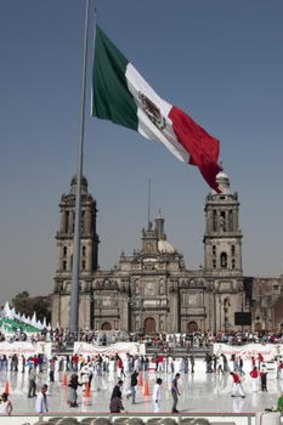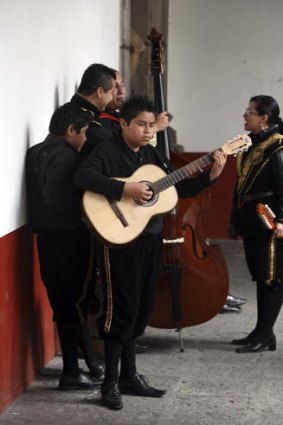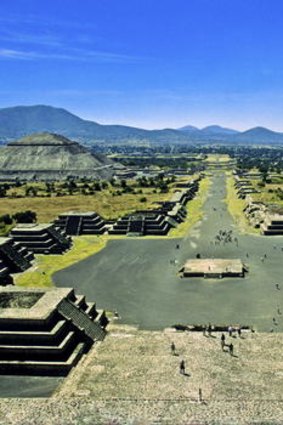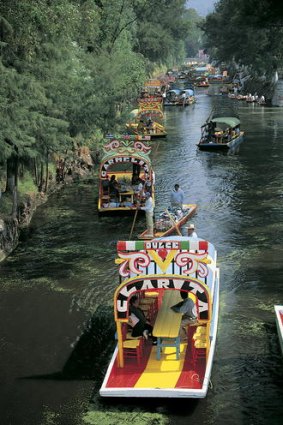This was published 8 years ago
Twenty reasons to visit Mexico City
From the metro to mezcal, there's plenty to love about Mexico City, writes Lance Richardson.

Zocalo.Credit: Getty Images
1 Zocalo
Arguably the heart of Mexico City, this vast square — officially named the Plaza de la Constitucion — is bordered by the Palacio Nacional and grand colonnaded buildings. This is where you come to gain a snapshot of the city: cars speed around the outskirts while street vendors crush up against the Metropolitan Cathedral, selling everything from tacos to kitsch collectables stamped with the face of Frida Kahlo. The Zocalo is often filled with the cluttered assembly of various parades and religious events; at Christmas it's fitted out in neon.
2 Templo Mayor

Artwork at the Soumaya museum.
Mexico City is built over the remains of the legendary Aztec city of Tenochtitlan. In 1978, maintenance men from a local electrical company were doing routine excavation work to the north-east of the Zocalo. What they discovered was a huge stone disc (3.25 metres in diameter) engraved with the dismembered figure of Coyolxauhqui, the Aztec moon goddess. Subsequent archaeological digs have unearthed more than 7000 objects and part of the enormous Templo Mayor, an important religious structure in Tenochtitlan. The terrific museum is a must-see.
3 Casa de los Azulejos
Once an 18th-century palace, the House of Blue Tiles is now a home to the flagship store of the Sanborn's restaurant chain. In a venue popular for decades with artists and politicians, patrons eat tortilla soup and quesadillas beneath stunning murals by Orozco and Pacologue. Curiously, because Mexico City was built on Tenochtitlan (which itself was built on top of a lake), parts of the metropolis are now sinking. If you have dinner on the upper floor, hold on to the breadsticks.

Coyoacan.Credit: Getty Images
4 Mexico City Metro
Ignore the naysayers: the oft-maligned metro network is not as dangerous as people think, it's incredibly cheap and it's the second-largest train system in North America, turning a vast and complicated city into an open book. Plus, the stations are filled with charming flourishes that celebrate the city's rich cultural offerings. The Templo Mayor may be pretty much gone but visit the Zocalo station for an illuminating scale model.
5 Catedral Metropolitana

Teotihuacan.Credit: Getty Images
When it comes to that old sinking feeling, nothing beats the Metropolitan Cathedral of the Assumption of Mary of Mexico City. Sure, the church is impressive in all the usual ways but what makes it particularly notable is the dropping water table; as the city's residents literally drink away the ground from beneath their feet, the whole structure is condemned to a slow collapse. The south wing is nearly a metre lower than the rest of the building.
6 Rivera's murals
No visit to Mexico City is complete without a tour of the murals by legendary Mexican artist Diego Rivera. The most famous, perhaps, is Rivera's take on Mexico's history in the Palacio Nacional. The most enchanting (and cheeky) is Dream of a Sunday Afternoon in Alameda Park, tucked away in a small building on the edge of the Alameda. Mexico's heroes and villains are out in their Sunday best and the artist, depicted as a small boy, holds hands with Death. Humour in Mexico often runs to the morbid end of the spectrum.

Xochimilco, take a boat ride down the river.Credit: Getty Images
7 Palacio de Bellas Artes
More murals are on display in the neoclassical and art nouveau masterpiece of the Palace of Fine Arts, a centre of opera, dance and theatre. The interior is art deco (why have one style when you can have them all?) and often hosts small exhibitions. The best view over the building's facade is found by visiting the quiet coffee shop on the top floor of the nearby Sears department store. bellasartes.gob.mx.
8 Museo Soumaya
What do you do if you're the world's richest man? Well, if you're Carlos Slim, you roil controversy by possessing $US74 billion ($68.75 billion) in a country where per-capita income rarely surpasses $US14,500 a year. Then you open an art museum in a strange, wave-like structure of silver hexagons. The jury is still out on the quality of the museum's curatorship (the Los Angeles Times called it Slim's "vanity museum" last year) but in terms of spectacle and excess it's hard to beat. soumaya.com.mx.
9 La Casa Azul Museo Frida Kahlo
More modest in size but no less ostentatious in its uniquely Mexican way, the Frida Kahlo Museum (also known as the Blue House) is a wonderful tribute to the distinctive aesthetic of the artist. Her peacocks may be gone but the cobalt-blue buildings are filled with papier-mache sculptures, small artworks and many original pieces of furniture. Visitors hoping to see Kahlo's most famous painting, Los Dos Fridas, should head to the Museo del Arte Moderno. museofridakahlo.org.mx.
10 Coyoacan
While in Kahlo's neighbourhood, take a stroll around the gorgeous historic centre of Coyoacan, which retains its village atmosphere despite the enveloping sprawl of Mexico City. Leon Trotsky lived here for a while and Hernan Cortes declared it the first capital of New Spain in his jaw-dropping and often ridiculous conquest of the country's original inhabitants.
11 Colonia Roma
The "it" neighbourhood for the young and hip is undoubtedly Roma, filled with art galleries, bookshops and numerous cafes to sit around in and discuss revolution with urban hipsters secretly attached to their privileged lifestyle. The once staunchly aristocratic neighbourhood's French-style mansions have since been transformed into public institutions and restaurants, though the district retains its sense of art nouveau grandeur, particularly on Alvaro Obregon Avenue, which is lined with ash trees and sculptures.
12 The Red Tree House
Choosing where to stay in such an enormous city can be daunting. Just stay here. Not only is The Red Tree House positioned in the friendly and vibrant neighbourhood of Condesa, it's incredibly charming. The hosts will give you a glass of wine and ask you about your day — and yes, one of the hosts is actually a labrador. This is my benchmark for B&Bs throughout the world. theredtreehouse.com.
13 Bosque de Chapultepec
If people talk about Chapultepec Park, they actually mean the forest. Coming in at 686 hectares, this green haven is much the same as New York's Central Park: without it, the city would be all but uninhabitable. It's easy to pass hours just strolling the paths with chilli-coated papaya from the ubiquitous food stalls but Chapultepec actually holds a wealth of museums and even the city zoo. Its crown is the lofty Chapultepec Castle, in the centre of the park on top of "grasshopper hill". The castle once housed Emperor Maximilian I — before the Mexicans decided that monarchy wasn't for them, executing him and declaring a republic.
14 Museo Nacional de Antropología
If you see one thing in Mexico City, you should see the world-class National Museum of Anthropology. Galleries are clustered around a large courtyard with a single imposing pillar called "el paraguas". Pre-Hispanic culture is exhaustively detailed in all its iterations, from the Toltecs to the Mayans to the Mexica (now called Aztecs). Stone statues, some for grisly sacrificial rituals, sit alongside masks, dioramas, scrolls and textile samples. An obligatory stop is the Piedra del Sol (Stone of the Sun), made famous through tacky tourist souvenirs; and the haunting headless statue of Coatlicue, which puts Hollywood monsters to shame. mna.inah.gob.mx.
15 Visit a market
A short cut to the spirit of a place is through its markets. Go where the locals go and get a sense of what it feels like to live and eat like a Mexican urbanite. Hit the Sonora market for ceramics, and Ciudadela on Balderas Avenue for Mexican arts and crafts. Other markets at San Juan, Jamaica and La Merced are also worth a visit. Unless you are a sicario (trained assassin) able to defend yourself, stay away from the labyrinthine market at Tepito.
16 Street food
Who's afraid of a little street food? Here's a hint: if the locals are eating it, chances are it's free from the bacterial taint of "Montezuma's revenge" (a much-loathed relative of "Delhi belly"). Part of the glorious nature of much Mexican food is its convenience — a taco, or torta (hot sandwich), is a fast and delicious meal for the time-strapped traveller. If you're still unsure about minced chorizo, stick to quesadillas, filled with stringy white Oaxacan cheese.
17 Mezcal
It seems that Mexicans rarely drink Coronas with lime (a Western affectation) but they rarely turn down good tequila. Lesser known internationally is tequila's relative, mezcal, derived from the maguey plant and possessing a strong smoky flavour. Dedicated mezcal bars known as mezcalerias are a growing trend in Mexico City and Condesa's La Botica leads the pack, with an underground vibe featuring tin tables and handwritten menus on pieces of cardboard. Wisely, the bar mandates that you order food with drinks. labotica.com.mx.
18 Teotihuacan
Just to the north-east of Mexico City, the dead city of Teotihuacan ("the place where the gods were created") rises from the plains in a complex of pre-Columbian pyramids. The original inhabitants remain shrouded in mystery, though the city had a strong influence on the latter-day Aztecs. The most visited archaeological site in Mexico, it's often teeming with visitors keen to see what the UNESCO fuss is about. Never mind, the view from the top of the Pyramid of the Moon is worth any crowd.
19 Lucha libre
Is there anything stranger than lucha libre? This form of freestyle wrestling has become world-famous for the coloured masks worn by combatants. The bell rings, the crowd is electrified and two tank-like men battle it out in glam costumes that make you wonder how they even see each other. The first lucha libre masks were created at Deportes Martinez, which sells them to this day. Grab your own version, then head to Arena Mexico to watch the professionals. mtzwear.com; arenamexico.com.mx.
20 Xochimilco
Take ancient canals and add modern chaos: technicolour gondolas (called "trajineras"), loud Mexican families, floating mariachi bands and women selling corn from canoes. One of the most enjoyable outings in Mexico City is embraced by locals and visitors alike, who split their time between being terrified they're about to crash, and being completely inebriated and encouraging crashes in the style of dodgem cars. xochimilco.df.gob.mx.
Sign up for the Traveller Deals newsletter
Get exclusive travel deals delivered straight to your inbox. Sign up now.